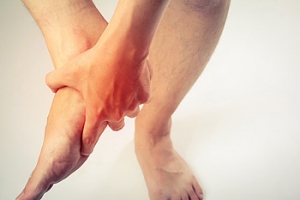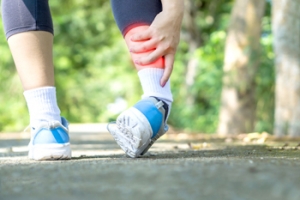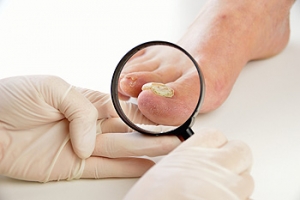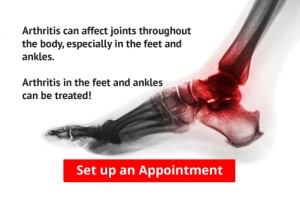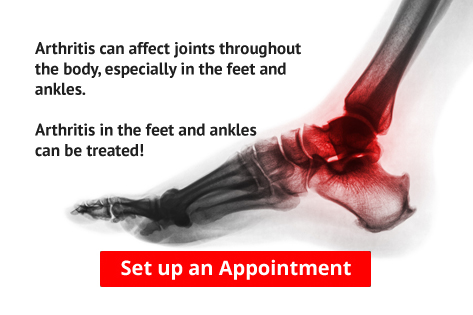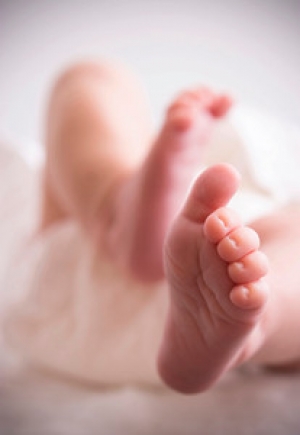
Heel Pain
Have you ever gotten up from a chair or out of bed in the morning, and upon taking that first step, feel like your heel has stepped on a tack? Many people experience a feeling of sharp pain which radiates into their arch from their heel and which does not allow them to put their heel on the floor. Sometimes they need to sit back down, stand only on their toes and use the wall for balance. If you can take a few steps, it seems to go away and lessen, allowing you to then resume your activity. Later, throughout your day and after a period of rest, it can happen again. If this sounds familiar you may be suffering from your first attack of heel pain.
Heel pain is a debilitating condition that affects day to day activities. Running and walking both causes stress on the heel because the heel is the part of the foot that hits the ground first. This means that the heel is taking on your entire weight. Diagnosis and treatments for heel pain can be easily found through your podiatrist.
Plantar Fasciitis
One of the main causes of heel pain is a condition known as plantar fasciitis. The plantar fascia is a band of tissue that extends along the bottom of the foot, from the toe to the bottom of the heel. A rip or tear in this ligament can cause inflammation of these tissues, resulting in heel pain. People who do not wear proper fitting shoes are often at risk of developing problems such as plantar fasciitis. Unnecessary stress from ill-fitting shoes, weight change, excessive running, and wearing non-supportive shoes on hard surfaces are all causes of plantar fasciitis.
Achilles Tendonitis
Achilles tendonitis is another cause of heel pain. Similar to plantar fasciitis, inflammation of the Achilles tendon will cause heel pain due to stress fractures and muscle tearing. A lack of flexibility of the ankle and heel is an indicator of Achilles tendonitis. If left untreated, this condition can lead to plantar fasciitis and cause even more pain on your heel.
Heel Spur
A third cause of heel pain is a heel spur. A heel spur occurs when the tissues of the plantar fascia undergo a great deal of stress, leading to a separation of the ligament from the heel bone entirely. This results in a pointed fragment of bone on the ball of the foot, known as a heel spur.
Symptoms of Cuboid Syndrome
 The pain and discomfort that is often associated with cuboid syndrome is typically found on the outside of the foot. It occurs if the cuboid bone becomes dislocated, and this can be from a result of an ankle sprain or it can gradually develop from a stress fracture. Some of the symptoms that are often experienced by patients who have cuboid syndrome can include swelling and tenderness on the outside of the foot, and it may be difficult to stand or walk. Mild relief can be felt by resting the foot as often as possible, and additional support may be obtained by taping the foot and ankle. Research has indicated it is beneficial to perform stretches and exercises as quickly as possible after the injury has occurred, as this may help the foot to become stronger. If you feel you may have cuboid syndrome, it is suggested that you speak to a podiatrist who can properly treat this condition.
The pain and discomfort that is often associated with cuboid syndrome is typically found on the outside of the foot. It occurs if the cuboid bone becomes dislocated, and this can be from a result of an ankle sprain or it can gradually develop from a stress fracture. Some of the symptoms that are often experienced by patients who have cuboid syndrome can include swelling and tenderness on the outside of the foot, and it may be difficult to stand or walk. Mild relief can be felt by resting the foot as often as possible, and additional support may be obtained by taping the foot and ankle. Research has indicated it is beneficial to perform stretches and exercises as quickly as possible after the injury has occurred, as this may help the foot to become stronger. If you feel you may have cuboid syndrome, it is suggested that you speak to a podiatrist who can properly treat this condition.
Cuboid syndrome, also known as cuboid subluxation, occurs when the joints and ligaments near the cuboid bone in the foot become torn. If you have cuboid syndrome, consult with one of our podiatrists from University Foot and Ankle Center, L.L.C. Our doctors will assess your condition and provide you with quality foot and ankle treatment.
Cuboid syndrome is a common cause of lateral foot pain, which is pain on the outside of the foot. The condition may happen suddenly due to an ankle sprain, or it may develop slowly overtime from repetitive tension through the bone and surrounding structures.
Causes
The most common causes of cuboid syndrome include:
- Injury – The most common cause of this ailment is an ankle sprain.
- Repetitive Strain – Tension placed through the peroneus longus muscle from repetitive activities such as jumping and running may cause excessive traction on the bone causing it to sublux.
- Altered Foot Biomechanics – Most people suffering from cuboid subluxation have flat feet.
Symptoms
A common symptom of cuboid syndrome is pain along the outside of the foot which can be felt in the ankle and toes. This pain may create walking difficulties and may cause those with the condition to walk with a limp.
Diagnosis
Diagnosis of cuboid syndrome is often difficult, and it is often misdiagnosed. X-rays, MRIs and CT scans often fail to properly show the cuboid subluxation. Although there isn’t a specific test used to diagnose cuboid syndrome, your podiatrist will usually check if pain is felt while pressing firmly on the cuboid bone of your foot.
Treatment
Just as the range of causes varies widely, so do treatments. Some more common treatments are ice therapy, rest, exercise, taping, and orthotics.
If you have any questions, please feel free to contact one of our offices located in East Brunswick and Monroe Township, NJ. We offer the newest diagnostic and treatment technologies for all your foot care needs.
Read more about Cuboid Syndrome
Cuboid Syndrome
All About Cuboid Syndrome
Though cuboid syndrome predominately affects athletes, non-athletes can suffer from it too. Cuboid syndrome is also called cuboid subluxation or cuboid fault syndrome, and occurs when a joint or ligament near the cuboid bone of the foot becomes damaged, or when the bone itself is dislodged from its natural position. Pain may be persistent, or come and go, and it is usually marked by the outside of the foot. Cuboid syndrome, unless severe, can be difficult to diagnose. A doctor will likely ask questions about how long the pain has been present, and will apply pressure on the cuboid bone to determine the origin of pain.
There are a number of causes that can lead to the syndrome. Due to athletic activities, repeated stress placed on the foot can cause cuboid subluxation. Ballet dancers, runners, and other athletes often develop this condition. Basketball or tennis players may also develop this condition, as they place stress on their feet while moving side to side. Cuboid syndrome can often develop over time; however it can come out of a sudden injury as well. Over pronation, or other problems with feet, can exacerbate the condition if not corrected.
Among podiatrists, there is some disagreement about the treatment, as well as the definition of cuboid syndrome. Some see the injury as an injury to the ligaments located nearby the cuboid bone, while others believe it refers to the dislocation of the calcaneal-cuboid joint only. Treatment opinions differ as well. Although it can be treated by manipulation in order to reposition the bone, this must be done with extreme care in order to avoid injury. Some doctors, however, prefer treatment through the use of orthotic pads, designed to keep the bone in its place. Effectiveness of these treatments may vary, according to the severity of the injury.
When you experience side foot pain, it is important that you seek medical assistance. If a subluxed cuboid is caught and treated early, treatment is usually successful, and individuals may begin activities such as sports when the pain subsides. If left untreated, the pain will worsen, and the condition could cause permanent damage.
Tips for Preventing Foot and Ankle Injuries
Foot and ankle injuries are very common in sports, especially among people that play tennis, soccer and run on a regular basis. That is why it is necessary to take some precautions in order to prevent injury. To start off, it is important to warm up the muscles before a sporting activity. Doing a light stretch and a slow jog for two to three minutes will do the trick. A second tip is to condition your muscles. The amount of time spent on a certain activity should be increased gradually over a period of a couple weeks to build both muscle strength and mobility. A third tip is to choose athletic shoes that specifically fit your foot type. People whose feet pronate or who have low arches need shoes that provide support in both the front of the shoe and under the arch. It is also recommended to choose a shoe with more cushion and a softer platform. A fourth tip is to avoid running or stepping on uneven surfaces. Holes, tree stumps, roots and paths with a rocky terrain or loose gravel should be avoided when running. If you have ankle problems, it is best to run on a softer surface like asphalt instead of concrete. A final tip is to listen to your body. If foot and ankle pain is experienced during a sport, you should stop taking part in the activity until the pain fully subsides. It is vital to go through a full rehabilitation process before returning to the sport. This is done to prevent any recurrent injuries. If you have sustained a foot or ankle injury while playing a sport, it is advised to see a podiatrist.
sports, especially among people that play tennis, soccer and run on a regular basis. That is why it is necessary to take some precautions in order to prevent injury. To start off, it is important to warm up the muscles before a sporting activity. Doing a light stretch and a slow jog for two to three minutes will do the trick. A second tip is to condition your muscles. The amount of time spent on a certain activity should be increased gradually over a period of a couple weeks to build both muscle strength and mobility. A third tip is to choose athletic shoes that specifically fit your foot type. People whose feet pronate or who have low arches need shoes that provide support in both the front of the shoe and under the arch. It is also recommended to choose a shoe with more cushion and a softer platform. A fourth tip is to avoid running or stepping on uneven surfaces. Holes, tree stumps, roots and paths with a rocky terrain or loose gravel should be avoided when running. If you have ankle problems, it is best to run on a softer surface like asphalt instead of concrete. A final tip is to listen to your body. If foot and ankle pain is experienced during a sport, you should stop taking part in the activity until the pain fully subsides. It is vital to go through a full rehabilitation process before returning to the sport. This is done to prevent any recurrent injuries. If you have sustained a foot or ankle injury while playing a sport, it is advised to see a podiatrist.
Foot and ankle trauma is common among athletes and the elderly. If you have concerns that you may have experienced trauma to the foot and ankle, consult with one of our podiatrists from University Foot and Ankle Center, L.L.C. Our doctors will assess your condition and provide you with quality foot and ankle treatment.
Foot and ankle trauma cover a range of injuries all over the foot; common injuries include:
- Broken bones
- Muscle strains
- Injuries to the tendons and ligaments
- Stress fractures
Symptoms
Symptoms of foot and ankle injuries vary depending on the injury, but more common ones include:
- Bruising
- Inflammation/ Swelling
- Pain
Diagnosis
To properly diagnose the exact type of injury, podiatrists will conduct a number of different tests. Some of these include sensation and visual tests, X-rays, and MRIs. Medical and family histories will also be taken into account.
Treatment
Once the injury has been diagnosed, the podiatrist can than offer the best treatment options for you. In less severe cases, rest and keeping pressure off the foot may be all that’s necessary. Orthotics, such as a specially made shoes, or immobilization devices, like splints or casts, may be deemed necessary. Finally, if the injury is severe enough, surgery may be necessary.
If you have any questions, please feel free to contact one of our offices located in East Brunswick and Monroe Township, NJ. We offer the newest diagnostic and treatment technologies for all your foot care needs.
Read more about Foot and Ankle TraumaFoot and Ankle Trauma
The foot and ankle area works with 26 bones, 33 joints, and more than 100 different muscles, tendons, and ligaments. Problems with any parts of this network can result in some kind trauma within the foot and ankle area. Most foot and ankle trauma is a result of aging or intense activities such as sports. However, trauma in this area can also be the result of simple things such as wearing heels too much or even walking on an uneven pavement. There are several kinds of symptoms related to specific injuries, and there are also several different treatments that could be used as well.
Foot Injuries and Symptoms
Some common injuries in the feet include stress fractures and bunions. Stress fractures are small cracks in a bone or severely bruised parts of the bone. This type of injury is caused by intense and repetitive activity, which is found in actions involved with sports and exercise. Symptoms of this injury include pain, swelling, tenderness, and possible bruising. Another common injury with bones is also bunions, which are bony bumps typically formed on the big and little toes. This injury is typically a result from wearing high heels and unfit shoes. Some common symptoms are swelling around the big and little toe areas, as well as pain and restricted movement.
Ankle Injuries and Symptoms
The common injuries associated with ankle trauma consist of sprains, strains, and fractures. These injuries are defined by the type of tissue that has been damaged. Fractures are breaks within the bones caused by sudden impacts to the area. Sprains relate to any damage of the ligaments, commonly caused by being stretched beyond their normal range of motion. Strains are attributed to damage of the muscles and tendons from being pulled too far. Symptoms of these injuries include severe pain, limited range of motion, and swelling.
Diagnosis and Treatment
Since there are several types of injuries with a variety of symptoms, it is important to see a podiatrist about your condition. Podiatrists can run a variety of tests to diagnose an injury accurately. This includes physical examinations, X-rays, or MRIs. A podiatrist may even run a stress test, which is an X-ray taken while pressure is applied to the damaged area. Once your injury has been diagnosed, the doctor may have you wear a cast or a splint, or gradually develop your range of motion. Severe injuries may require physical therapy or even surgery if necessary. If you have any concerns from past foot and ankle trauma experiences, consult with one of our podiatrists from University Foot and Ankle Center, L.L.C. Our doctors can assess your condition and provide you with quality foot and ankle treatment.
If you have any questions, please feel free to contact one of our offices located in East Brunswick and Monroe Township, NJ. We offer the newest diagnostic and treatment technologies for all your foot care needs.
What Is the Medical Term for Toenail Fungus?
 A common foot ailment that many patients suffer from is known as toenail fungus. The medical term for this contagious condition is referred to as “onychomycosis”. There are several noticeable symptoms that are associated with toenail fungus including thickening of the nail, discoloration, and cracking. Diabetic patients may be more susceptible, due to a weakened immune system. Additionally, if there has been an injury that has happened to the nail, or if circulation problems exist, these conditions may lead to the development of toenail fungus. Research has indicated that there are methods that can be implemented which may help to prevent this condition from occurring. These can include wearing appropriate shoes while in public swimming pools and surrounding areas, avoiding sharing nail clippers, and keeping the feet clean and dry. If you have this ailment, please consult with a podiatrist who can offer the proper treatment solutions.
A common foot ailment that many patients suffer from is known as toenail fungus. The medical term for this contagious condition is referred to as “onychomycosis”. There are several noticeable symptoms that are associated with toenail fungus including thickening of the nail, discoloration, and cracking. Diabetic patients may be more susceptible, due to a weakened immune system. Additionally, if there has been an injury that has happened to the nail, or if circulation problems exist, these conditions may lead to the development of toenail fungus. Research has indicated that there are methods that can be implemented which may help to prevent this condition from occurring. These can include wearing appropriate shoes while in public swimming pools and surrounding areas, avoiding sharing nail clippers, and keeping the feet clean and dry. If you have this ailment, please consult with a podiatrist who can offer the proper treatment solutions.
For more information about treatment, contact one of our podiatrists of University Foot and Ankle Center, L.L.C. Our doctors can provide the care you need to keep you pain-free and on your feet.
Toenail Fungus Treatment
Toenail fungus is a condition that affects many people and can be especially hard to get rid of. Fortunately, there are several methods to go about treating and avoiding it.
Antifungals & Deterrence
Oral antifungal medicine has been shown to be effective in many cases. It is important to consult with a podiatrist to determine the proper regiment for you, or potentially explore other options.
Applying foot powder on the feet and shoes helps keep the feet free of moisture and sweat.
Sandals or open toed shoes – Wearing these will allow air movement and help keep feet dry. They also expose your feet to light, which fungus cannot tolerate. Socks with moisture wicking material also help as well.
If you have any questions please feel free to contact one of our offices located in East Brunswick and Monroe Township, NJ. We offer the newest diagnostic tools and technology to treat your foot and ankle needs.
Read more about Toenail FungusToenail Fungus
Toenail fungus is a frustrating problem that affects many people. It can be persistent and hard to get rid of. As many different types of fungi are present throughout the environment, it is very easy to contract toenail fungus.
The feet are especially susceptible to toenail fungus because shoes and socks create the ideal dark and moist environment that fungal infections thrive in. While fungal infections of the nail plate are quite common, if left untreated they can spread beyond the toenail and into the skin and other parts of the body.
Signs of toenail fungus include a thickened nail that has become yellow or brown in color, a foul smell, and debris beneath the nail. The toe may become painful due to the pressure of a thicker nail or the buildup of debris.
Treatment for toenail fungus is most effective during the early stages of an infection. If there is an accumulation of debris beneath the nail plate, an ingrown nail or a more serious infection can occur. While each treatment varies between patients, your podiatrist may prescribe you oral medications, topical liquids and creams, or laser therapy. To determine the best treatment process for you, be sure to visit your podiatrist at the first signs of toenail fungus.
Arthritis Can Cause Pain in the Feet and Ankles
Successful Ways to Properly Care for Children's Feet
 When children’s feet are properly cared for, specific foot problems may be avoided as they get older. One of the first things parents can do for their children is to wash and dry their feet daily, especially between the toes. It is encouraged for toddlers to walk barefoot while indoors, and this may be helpful in strengthening the overall foot as the toes grasp the floor. When children are walking outdoors, it is beneficial to have your child’s feet measured, as this can help in determining that the correct size shoes are purchased. It is important that the toes have adequate room to move freely in, and socks should be made of breathable materials. Additionally, trimming your child’s toenails correctly may prevent ingrown toenails. If you would like more information about how to take care of children's feet, it is suggested that you speak to a podiatrist.
When children’s feet are properly cared for, specific foot problems may be avoided as they get older. One of the first things parents can do for their children is to wash and dry their feet daily, especially between the toes. It is encouraged for toddlers to walk barefoot while indoors, and this may be helpful in strengthening the overall foot as the toes grasp the floor. When children are walking outdoors, it is beneficial to have your child’s feet measured, as this can help in determining that the correct size shoes are purchased. It is important that the toes have adequate room to move freely in, and socks should be made of breathable materials. Additionally, trimming your child’s toenails correctly may prevent ingrown toenails. If you would like more information about how to take care of children's feet, it is suggested that you speak to a podiatrist.
Making sure that your children maintain good foot health is very important as they grow. If you have any questions, contact one of our podiatrists of University Foot and Ankle Center, L.L.C. Our doctors can provide the care you need to keep you pain-free and on your feet.
Keeping Children's Feet Healthy
Having healthy feet during childhood can help prevent medical problems later in life, namely in the back and legs. As children grow, their feet require different types of care. Here are some things to consider...
Although babies do not walk yet, it is still very important to take care of their feet.
Avoid putting tight shoes or socks on his or her feet.
Allow the baby to stretch and kick his or her feet to feel comfortable.
As a toddler, kids are now on the move and begin to develop differently. At this age, toddlers are getting a feel for walking, so don’t be alarmed if your toddler is unsteady or ‘walks funny’.
As your child gets older, it is important to teach them how to take care of their feet.
Show them proper hygiene to prevent infections such as fungus.
Be watchful for any pain or injury.
Have all injuries checked by a doctor as soon as possible.
Comfortable, protective shoes should always be worn, especially at play.
If you have any questions please feel free to contact one of our offices located in East Brunswick and Monroe Township, NJ. We offer the newest diagnostic and treatment technologies for all your foot and ankle needs.
Read more about What to Do to Keep Your Child’s Feet HealthyWhat to Do to Keep Your Child’s Feet Healthy
Being a parent involves caring for your child in every way you can. You make sure they are eating the right food, being nice to others, and staying out of any trouble. However, it is also important that you are watchful of their health, more specifically their foot health. Maintaining good foot health in childhood is important in preventing later conditions in life from happening. As children continue to develop, their feet require different techniques of care. Here are some various ways in which you can help your child’s feet stay healthy.
A baby needs a lot of care and attention overall, but the importance of their feet should never be forgotten. Before a baby turns one, their feet change and develop greatly. It is important that during this time, a mother avoids putting tight socks on their child. She should also encourage movement of their feet so the baby can begin to feel more comfortable using them.
As a baby enters the toddler years of his or her life, they are begin to walk around. When your baby begins to take those first steps, it is crucial that they are wearing protective shoes on their feet. As a mother that is observant of your child’s feet, you may notice changes in them. This is completely normal as the feet are becoming susceptible to the activity of walking. It is normal for a toddler to be a bit unsteady or to “walk funny” at first.
When your child grows out of their toddler years, it is important that you begin to show him or her how to care for their feet on their own. Practice with your child proper hygiene in order to prevent foot fungus or infection. Since children are constantly on the move, it is crucial to be cautious of any accidents or injuries that might occur. If an injury occurs, it is advised that you take your child to be examined by a doctor immediately. Since your child is still growing, particular injuries can shift the way in which a bone or other important part of the foot is developing.
Babies and kids are always changing and growing. Your job as a parent is to make sure they stay healthy and making sure they are properly maintained. This involves proper foot care and making sure the feet stay healthy. Following this guide, your child can live a long and happy life.
Blog Archives
- April 2024
- March 2024
- February 2024
- January 2024
- December 2023
- November 2023
- October 2023
- September 2023
- August 2023
- July 2023
- June 2023
- May 2023
- April 2023
- March 2023
- February 2023
- January 2023
- December 2022
- November 2022
- October 2022
- September 2022
- August 2022
- July 2022
- June 2022
- May 2022
- April 2022
- March 2022
- February 2022
- January 2022
- December 2021
- November 2021
- October 2021
- September 2021
- August 2021
- July 2021
- June 2021
- May 2021
- April 2021
- March 2021
- February 2021
- January 2021
- December 2020
- November 2020
- October 2020
- September 2020
- August 2020
- July 2020
- June 2020
- May 2020
- April 2020
- March 2020
- February 2020
- January 2020
- December 2019
- November 2019
- October 2019
- September 2019
- August 2019
- July 2019
- June 2019
- May 2019
- April 2019
- March 2019
- February 2019
- January 2019
- December 2018
- November 2018
- October 2018
- September 2018
- August 2018
- July 2018
- June 2018
- May 2018
- April 2018
- March 2018
- February 2018
- January 2018
- December 2017
- November 2017
- October 2017
- September 2017
- August 2017
- July 2017
- June 2017
- May 2017
- April 2017
- March 2017
- February 2017
- January 2017
- December 2016
- November 2016
- October 2016
- September 2016
- August 2016
- July 2016
- June 2016
- May 2016
- April 2016
- March 2016
- February 2016
- January 2016
- December 2015
- November 2015
- October 2015
- September 2015
- August 2015
- July 2015
- June 2015
- May 2015
- April 2015
- March 2015
- February 2015
- January 2015
- December 2014
- November 2014
- October 2014
- September 2014
- August 2014
- July 2014

